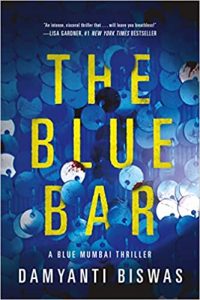Surviving the Long Haul: Negotiating the Challenges of Traditional Publication
Surviving the Long Haul: Negotiating the Challenges of Traditional Publication
 Someone I know converted traditional publication into a bingo as a joke, and posted it on our author group. It was for our amusement, but the laughs mostly came from the fact that all of us had been in one of those situations at some time or the other.
Someone I know converted traditional publication into a bingo as a joke, and posted it on our author group. It was for our amusement, but the laughs mostly came from the fact that all of us had been in one of those situations at some time or the other.
So much of traditional publishing wisdom is considered axiomatic—everyone entering the industry is supposed to be in the know, but the truth is, not many are. We all learn from those who have been on the journey before us, and from others who are walking right alongside. We read social media posts and blogs, and more often than not, learn from our own experiences.
Not all authors or books are the same, and wisdom varies according to genre, but here are a few notes from my own brief experience as a US debut this year, with my literary crime novel, THE BLUE BAR:
1. Do not equate publication history with talent. Quality is key, but so is timing. Writing is art; publishing, a business. Some of my very talented friends are in the querying trenches. With the right editor and agent at the right time, they’re likely to fly high.
People with agents and book deals seem to develop a halo in the eyes of those in the slush pile, but in the current publishing climate, the truth is that authors who have successfully published a few books or are agented can find themselves back in the query trenches. Publishers and agents are focused on the business aspect. Changing or losing them is part of the process.
2. Write for yourself, because writing to market can turn into a huge burden. I say this even as an author who has recently written a sequel on contract. The Blue Bar was supposed to be a standalone, and I sold a series. I’ve just rewritten The Blue Monsoon the third time, and must read it at least four more times. Multiple readings and edits on a story that I can get behind is easier than one that I can’t. When in the querying trenches, it might feel tempting to write as per agent wish-lists, but trends pass and a story written with passion might stand a better chance than one written per rote.
3. Write in the face of rejection. Each rejection is one less door to knock. This can be a long hard road, whether in the querying trenches, on submission, or when submitting proposals to your editor. The sad thing is, unless you hit the very top tier of awards or bestsellerdom, rejections never really go away. Someone is bound to say no to you. And if no one does, readers will, which brings me to the next point.
4 . No book will be loved by everyone—that’s just the facts. For every classic, prize-winning book, there are miles upon miles of one-star reviews. Most authors don’t read reviews because it can be so damaging to the fragile writing self—but you should do what works for you as long as you remember that low-stars are a part of the process.
5. Marketing and publicity are a huge part of a book’s success, but not failsafe. Even the best-marketed and buzziest books fail. No one knows the secret to infallible success.
Yes, some of your books won’t take off, but others will. Even the most successful author has had a dud or two, and there’s very little to be done about it. You can only do your bit to help your book via social media and events, which brings me to the next point.
6. Social media helps, but can’t be the only thing pushing sales. With viral tiktoks leading to huge sales, everyone has joined the social media bandwagon. In some categories, like YA, Romance and Fantasy, Tiktoks and Instagram reels do help push the needle. In other genre, the jury is still out.
In the case of most authors, only about ten percent of followers end up buying books. Do what you enjoy on social media, but do not take on the entire psychological burden of your books sales on yourself. In trad publication, the publisher can do a lot more than an author when it comes to sales. Your best bet of building a good reader base is to write more books, and make them the best you can.
7. Take time to be gentle with yourself and others. Publishing is a long term game. Know who you are as a person and writer, and treat your inner writer with love and respect. One of the best ways to ride the publishing rollercoaster is to follow a rock-solid self-care routine. And the same generosity and kindness, when shown to your fellow authors, is likely to be the best investment of your non-writing time. Celebrate everyone’s journey in the same spirit as you do your own.
8. Focus on Your journey, and persevere. Comparison can be the thief of joy. Not all publishers are equal when it comes to marketing and publicity. And not all books will find the same buzz—luck and timing are just as important as the quality of the book and the marketing machine behind it.
Again, publishing is a long-term game, and if you don’t let yourself be discouraged by setbacks, you might find that magic combination of quality, timing, marketing/ publicity.
This is by no means a comprehensive guide. In a rapidly changing industry, traditional publishing can feel like a daunting and uncertain path, especially with the rise of self-publishing. Persevering in the face of failure, and a strong self-care routine will stand you in good stead as you go on the long haul in trad publication.
—
Damyanti Biswas is the author of You Beneath Your Skin and numerous short stories that have been published in magazines and anthologies in the US, the UK, and Asia. She has been shortlisted for Best Small Fictions and Bath Novel Awards and is coeditor of the Forge Literary Magazine.
Apart from being a novelist, she is an avid reader of true crime, a blogger, and an animal lover. Her ambition has always been to live in a home with more books than any other item, and she continues to work toward that.
Find out more about her on her website https://www.damyantiwrites.com/
THE BLUE BAR
 On the dark streets of Mumbai, the paths of a missing dancer, a serial killer, and an inspector with a haunted past converge in an evocative thriller about lost love and murderous obsession.
On the dark streets of Mumbai, the paths of a missing dancer, a serial killer, and an inspector with a haunted past converge in an evocative thriller about lost love and murderous obsession.
After years of dancing in Mumbai’s bars, Tara Mondal was desperate for a new start. So when a client offered her a life-changing payout to indulge a harmless, if odd, fantasy, she accepted. The setup was simple: wear a blue-sequined saree, enter a crowded railway station, and escape from view in less than three minutes. It was the last time anyone saw Tara.
Thirteen years later, Tara’s lover, Inspector Arnav Singh Rajput, is still grappling with her disappearance as he faces a horrifying new crisis: on the city’s outskirts, women’s dismembered bodies are being unearthed from shallow graves. Very little links the murders, except a scattering of blue sequins and a decade’s worth of missing persons reports that correspond with major festivals.
Past and present blur as Arnav realizes he’s on the trail of a serial killer and that someone wants his investigation buried at any cost. Could the key to finding Tara and solving these murders be hidden in one of his cold cases? Or will the next body they recover be hers?
BUY HERE
Category: Contemporary Women Writers, How To and Tips


























Excellent piece, thank you!
I’ve been down almost every road — self-publishing, hybrid publishing, querying trenches (where I currently am trending water) — and so far I’ve discovered that ALL routes come with pros and cons. Wisely, I’ve always written what I was passionate about, so at least, regardless of outcome, I could always be pleased and proud of my work.
But wow… trying to get an agent in the current climate has proven, for me, to be a SLOG in all caps! But we soldier on… 🙂